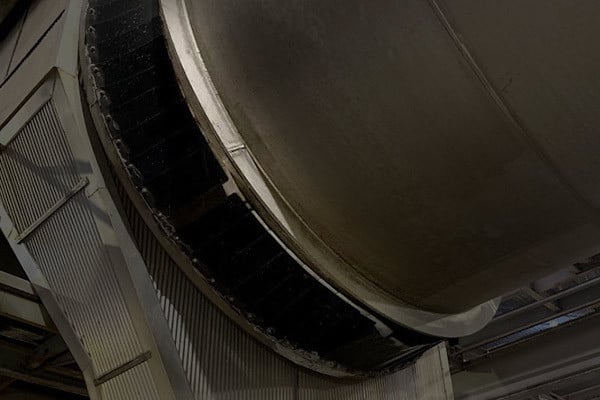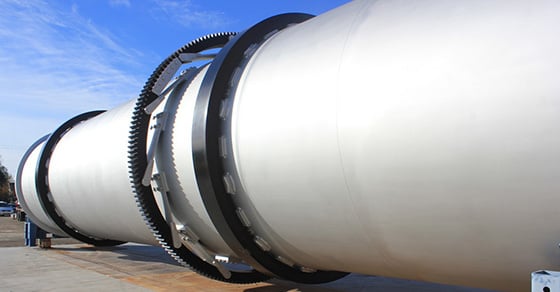The shell is the central component of any type of rotary drum equipment, from rotary drum dryers, coolers, and kilns, to granulators and coating drums. Since problems with the shell often end in catastrophic failure, early identification of an issue is essential to ensuring that drum shell integrity is maintained and premature failure is avoided.
The good news is that almost all shell issues can be averted by selecting a heavy-duty drum designed around the unique application, and implementing a preventative maintenance program that emphasizes routine inspections.
What Causes Rotary Drum Shell Issues
Rotary drum operators and maintenance technicians should be well versed in the causes of shell problems, the types of issues that can occur, and what to look for to spot a potential problem before it has a chance to escalate.
Rotary drum shell issues may occur for a variety of reasons, but there are two overarching themes: under-built drums and improper operation.
Under-built Drums (Inadequate Manufacturing or Light-Duty Equipment)
One of the most common causes of shell trouble is an under-built drum.
Not all rotary drums are created equal; the market selection ranges from light-duty to heavy-duty and includes everything in between. In selecting a rotary drum for a given application, care must be taken in matching the build quality of the drum with the demands of the intended application.
Weld quality, manufacturing practices, materials of construction, and more, must all meet or exceed the demands of the application, with the material to be processed playing a significant role. A drum that is not manufactured to such specifications can suffer from several issues:
Ovality
Ovality refers to the amount of flex a drum shell is capable of and is typically only a concern when working with refractory-lined rotary kilns.
While a small amount of ovality is acceptable, allowing ovality to go beyond a certain threshold causes refractory failure. Failure occurs because refractory linings are more rigid and less forgiving than drum shells, causing a conflict between the shell and refractory if the shell flexes too much.
The amount of ovality a drum experiences is largely a result of the materials of construction, combined with shell thickness and manufacturing techniques. And while ovality can be minimized by increasing shell thickness, as thickness increases, so too do material costs and pressure loads on the drum’s base. As such, engineers must work to find a balance between these factors during the rotary drum design process.
Ovality has a compounding effect, putting added stress on the drum, which further exacerbates the ovality issue, creating an endless cycle of problems. Any defects in the drum are likely to be exacerbated by an ovality problem as well.
Identifying Shell Ovality Problems
An ovality problem is often indicated by a failure in refractory, as well as cracks in the drum shell, and should be addressed promptly to minimize damage and avoid premature failure. Special testing equipment is needed to truly confirm a suspected ovality issue.
Treating Shell Ovality Issues
Unfortunately, the only true way to fix an ovality issue is to replace the unit. Depending on the severity, there may be a few options to temporarily manage the issue and prevent further damage; when caught early, various structural implements can be incorporated, such as stiffening rings, wrapper bands, ribs, or the addition of material to the drum shell’s exterior (and sometimes the interior as well).

A rotary drum stiffening ring is highlighted in the image above.
These measures are generally considered temporary and ultimately, the drum will need to be replaced at some point.
Thin Spots (Drum Shell Thickness Degradation)
A light-duty or underbuilt drum may also experience thin spots in the shell. Thin spots are a structural degradation that eventually cause the shell to break apart. If an adequate thickness is not selected for shell construction, the shell is likely to experience increased wear that will eventually result in thin spots.
The presence of corrosion or abrasion will expedite this wear. As such, a well-built drum will be designed to abate potential corrosion and abrasion. Potash drums, for example, are built using a much greater shell thickness, because it is widely recognized that potash will corrode the shell over time. Abrasion or corrosion may also occur when there is a change in feedstock.
Identifying Thin Spots
Thinning spots in a drum shell are all too often recognized too late, when a worn spot has become severe enough to allow material to escape. For this reason, routine inspections of the drum’s interior are essential to early identification of wear.
Apart from localized signs of wear, widespread wear may be indicated by the appearance of raised welds. This is particularly true when a shell is thinning due to abrasion; since welds are harder than the base material, abrasivity will wear away the material around the welds first, making the welds appear raised.
Treating Thin Spots
Untreated thin spots will eventually cause the drum to break apart, totaling the entire shell in the process. For this reason, thin spots should not be left untreated.
Depending on the type and severity of wear, thin spots can be fixed by applying additional material to worn areas, cladding the exterior of the drum, or adding a liner to the drum’s interior. In cases of extreme and/or widespread wear, section, or even total drum shell replacement may be the best approach.

A replacement rotary drum dryer shell is fabricated at the FEECO manufacturing facility
Improper Operation
Apart from an ill-prepared or underbuilt drum, improper operation also has the potential to cause excessive shell wear and damage. While this is not typically an issue with granulation, coating, or cooling drums (in most cases), it is a concern with rotary dryers and kilns, because heat is involved. The primary concern when working with rotary dryers and kilns is warping.
Warping (Rotary Drum Dryers & Rotary Kilns Only)
Warp, or deflection, occurs when heat is unevenly distributed across the drum shell. If the temperature is allowed to go beyond the yield strength of the shell material, permanent deformation will occur.
Warping can occur if a drum is run empty, or if a drum is run without rotation. If not rotated, heating becomes localized on the shell, causing the drum to sag, resulting in warp.
Identifying a Warped Shell
A warped shell is highly problematic, causing subsequent issues with breaching and seal interfaces, gear mesh, drum training, and more. As such, problems with these areas are good indications that warp may have occurred. Warp may be visibly noticeable as well; the drum may appear to sag, or may experience “coke bottling,” where the shell material bulges out around the tires. This bulging occurs because the tires are a harder material than the drum shell, so the shell becomes warped around the tires, which remain intact.
Treating a Warped Shell
If warping is minimal and localized, section replacement may be an option, but in almost all cases, the entire shell will require replacement. Any damage to breechings, gears, and seals will also need to be repaired as well.
Preventing Drum Shell Issues Through Annual Inspections
Annual rotary drum inspections are by far the most effective way to spot shell problems early, minimizing potential downtime and associated maintenance costs.
The FEECO Customer Service Team recommends inspections be conducted annually, with more demanding operations requiring more frequent checkups. As part of the inspection, Customer Service Engineers will carefully examine the drum shell both inside and out to check for any signs of wear.
In addition to the drum shell, FEECO Customer Service Engineers thoroughly review all mechanical components of the unit as part of the inspection, providing a detailed report on overall dryer, kiln, granulator, cooler, or coating drum health upon completion.

A FEECO Customer Service Engineer works with facility personnel to prepare for a rotary dryer inspection
Not surprisingly, annual inspections are the most cost-effective way to avoid excessive downtime, production losses, and potentially hundreds of thousands of dollars in repairs.
Conclusion
Rotary drum shell issues have the potential to be severe, causing catastrophic, premature failure. Issues such as ovality, thin spots, or warping may arise from inadequate manufacturing or through improper operation. For this reason, FEECO highly recommends annual inspections be conducted on all types of rotary drum equipment in order to catch issues before they have a chance to escalate.
FEECO is the leading provider of custom rotary drum dryers, kilns, coolers, granulators, and coating drums. Our extensive parts and service program has all the tools needed to keep rotary equipment running its best, even if it wasn’t built by FEECO. For more information on our rotary drums or parts and service support, contact us today!

